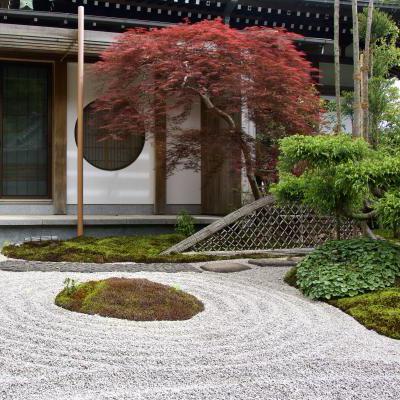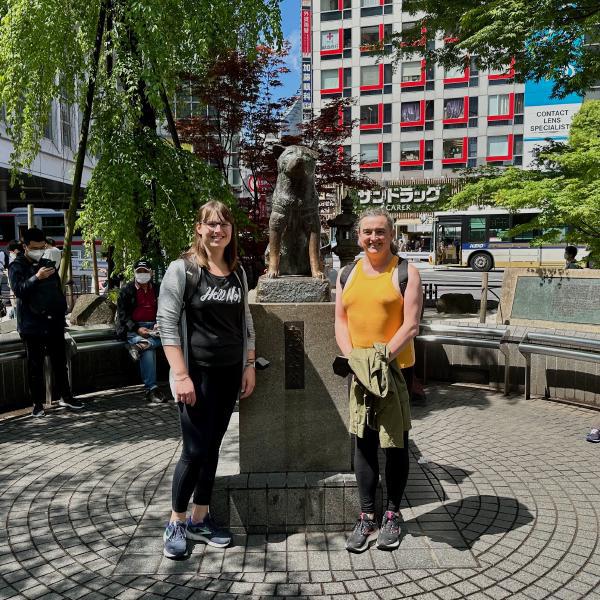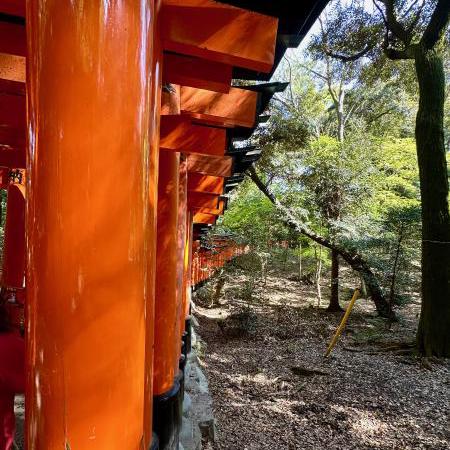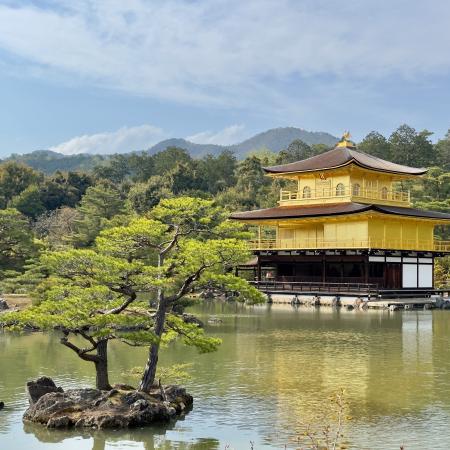Palace Eaves
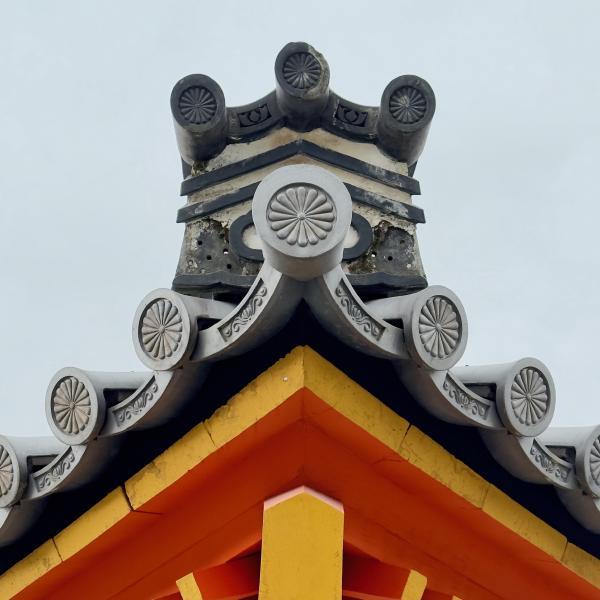
At the beginning of April 2023, Tess and I traveled to Japan for two weeks. She also wrote about her experience.
After a twelve hour flight from San Franciso, we landed in Ōsaka around 2:30 in the afternoon on Sunday. We cleared customs, and headed to the はるか Express from Ōsaka airport to Kyōto. We took a brief walk around the neighborhood to get our bearings, and found dinner at a tiny izakaya in an alley on the western side of Kyōto’s biggest river, the 鴨川 .
The next day we were up bright and early – thanks jet lag! – and headed to 伏見稲荷大社 a Shinto shrine covering an entire mountain known for its sprawling pathways lined with bright vermillion 鳥居 .

We had lunch with Tess’ friend and colleague Florian and his wife Namino at a nearby spot known for its grilled eel. That afternoon, we walked from our AirBnb up to 清水寺 , a Buddhist temple in the hills on the east side of Kyōto. We wandered back through Gion and down the arcade shopping streets in central Kyōto.
We ended the night at a newly-opened craft beer bar run by a French man with a substantial selection of craft beers from all over Japan.
The third day, we were up early again. We got a quick breakfast at a local place, and took the train to 奈良 , the ancient capital city of Japan. Nara’s main city park is home to hundreds of wild deer that tourists can feed with rice crackers bought from stands throughout the park.
The main draw for us was 東大寺 temple, a Buddhist temple in the middle of Nara Park that houses a truly enormous cast bronze Buddha. After visiting our biggest buddy, we grabbed lunch at a cafe in Nara and hopped back on the train to Kyōto.
Back in Kyōto, we took a bus up to 金閣寺 temple, a.k.a. the Golden Pavillion.
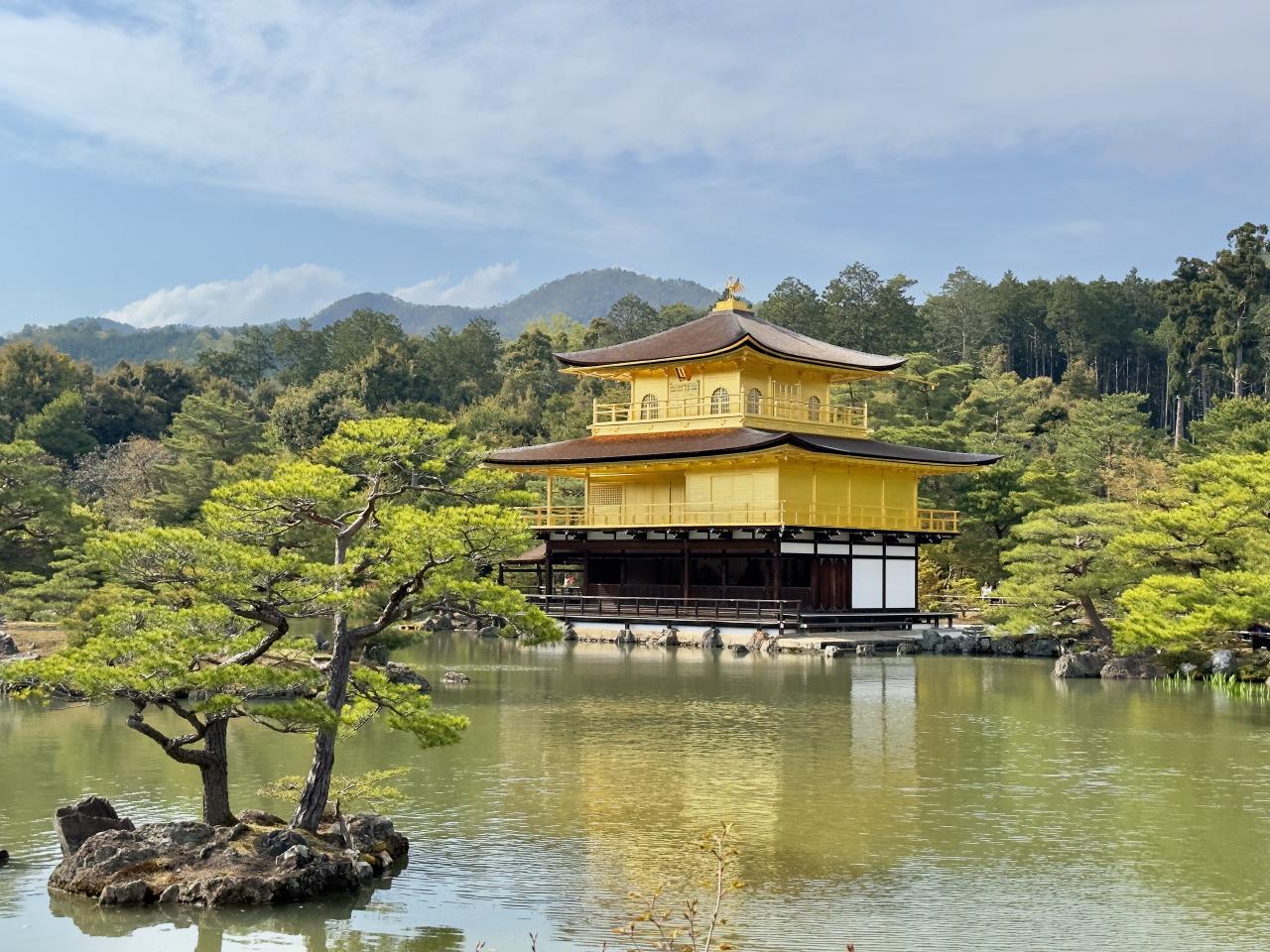
We ended the day with a stop at Beer Pub Takumiya, staffed by three gregarious and friendly Japanese guys. We got some much-needed time off our feet and had a good time chatting with them, and the Austrailian guy who sat next to us.
Dinner was one of the more challenging of the trip for me. We ended up at a small izakaya in an ally off one of Kyōto’s busy main streets. The menu was all Japanese, and the two guys behind the counter spoke very little English. We ordered a bunch of things, not really understanding what we were getting. It ended up being pretty tasty, but the difficulty in understanding the menu compounding with our hunger made it a frustrating experience.
Our fourth and final full day in Kyōto was rainy. We started with a stop at Lorimer Kyōto for a real Japanese breakfast. The food was fantastic, though we were both a little put off by the constant Christian praise music they played. We stopped at Walden Woods for a coffee on the way back to the Airbnb.
In the afternoon, we visited 平安神宮 . Wrapping around the shrine itself is a beautiful garden filled with native trees and plants, ponds and rivers. We wandered the pathways as the rain fell. It was rather lovely.
We walked from there to the Kyōto Handicrafts Center, stopped in a neaby place for udon, and took a bus over to the Imperial Palace in Kyōto-Gyoen. We had hoped to catch an English language tour, but it was canceled that day, so we took a brochure and wandered the grounds, marveling at the blending of Heian and Edo period architecture. The grounds have some lovely gardens too.
On the way to the palace we happened upon Tozando, a well-known shop selling martial arts gear, including 居合刀 and real 日本刀 . One of my goals for this trip was to buy a sword, and I did! It’s an iaitō, a practice sword with a dull edge, with wave patterns on the hand guard, and fish-shaped charms in the wrapping. I’m really pleased with it.
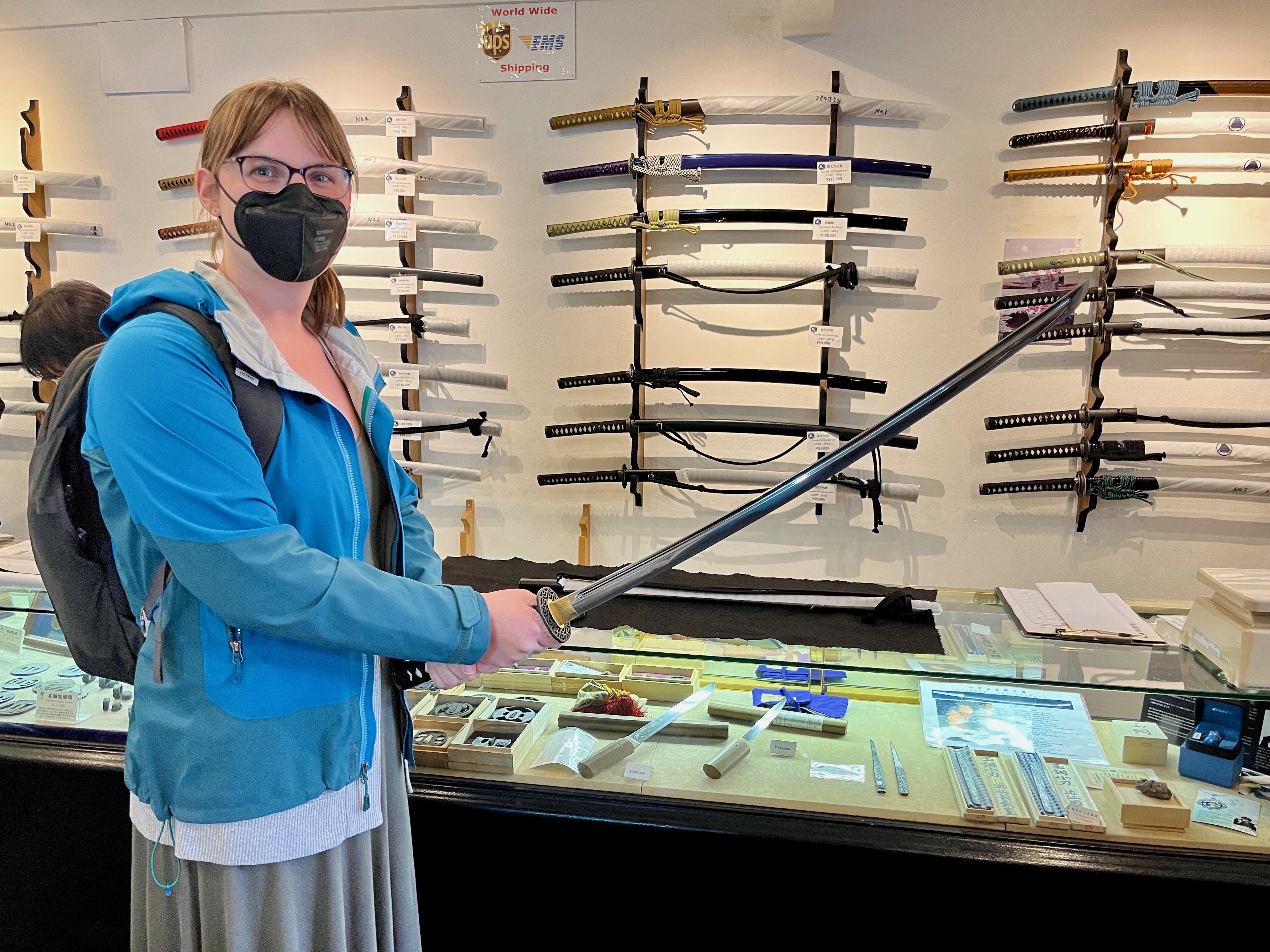
After our stop at Tozando, we met our friends Ana, Megumi, and their new baby Sen for dinner at their apartment near Kyōto University. Ana and Megumi are real foodies and pulled out all the stops for us: two very interesting bottles of sake, a 60-day dry aged ribeye, and a number of 京野菜 , or locally grown veggies. We wrapped it all up with freshly made mochi wrapped in mulberry leaves, and some popcicles.
Thursday was a travel day. We had breakfast and coffee in the morning, then packed up and checked out of our AirBnb. With a few hours to go until our train to 金沢 , we did some shopping and wrote some postcards. After a quick bowl of ramen for lunch, we caught the サンダーバード Express from Kyōto to Kanazawa.
We arrived at our ryokan in the late afternoon. The staff had clearly been waiting for us. They greeted us warmly and led us to our room where they offered us tea and a sweet. Our 仲居 , a very sweet and patient Japanese lady, educated us about how to wear our yukata and samue. We took some time to get settled in our room, bathed, and enjoyed our private onsen bath. Dinner was promptly at 19:00: an elaborate 解析 meal made up of a multitude of small dishes of all different kinds. After the busy-ness of Kyōto, it was so nice to have some down time and feel so well taken care of.

In the morning, our Japanese hostess brought us breakfast. Tess enjoyed the onsen in our room while I explored the public onsen on the grounds. Our ryokan had three public baths: one large gender-segregated bath downstairs, and two baths on the roof that swap between men-only and women-only at set times of day. Amazingly, I had both of the baths I tried to myself!
At 10 we took a shuttle to Mattō station and a local train to Kanazawa Station. In Kanazawa, we found Curio Espresso for a coffee, and walked to Kanazawa Castle and the 兼六園 garden. I really wanted to see a castle on this trip, so this was a particularly exciting day trip for me.
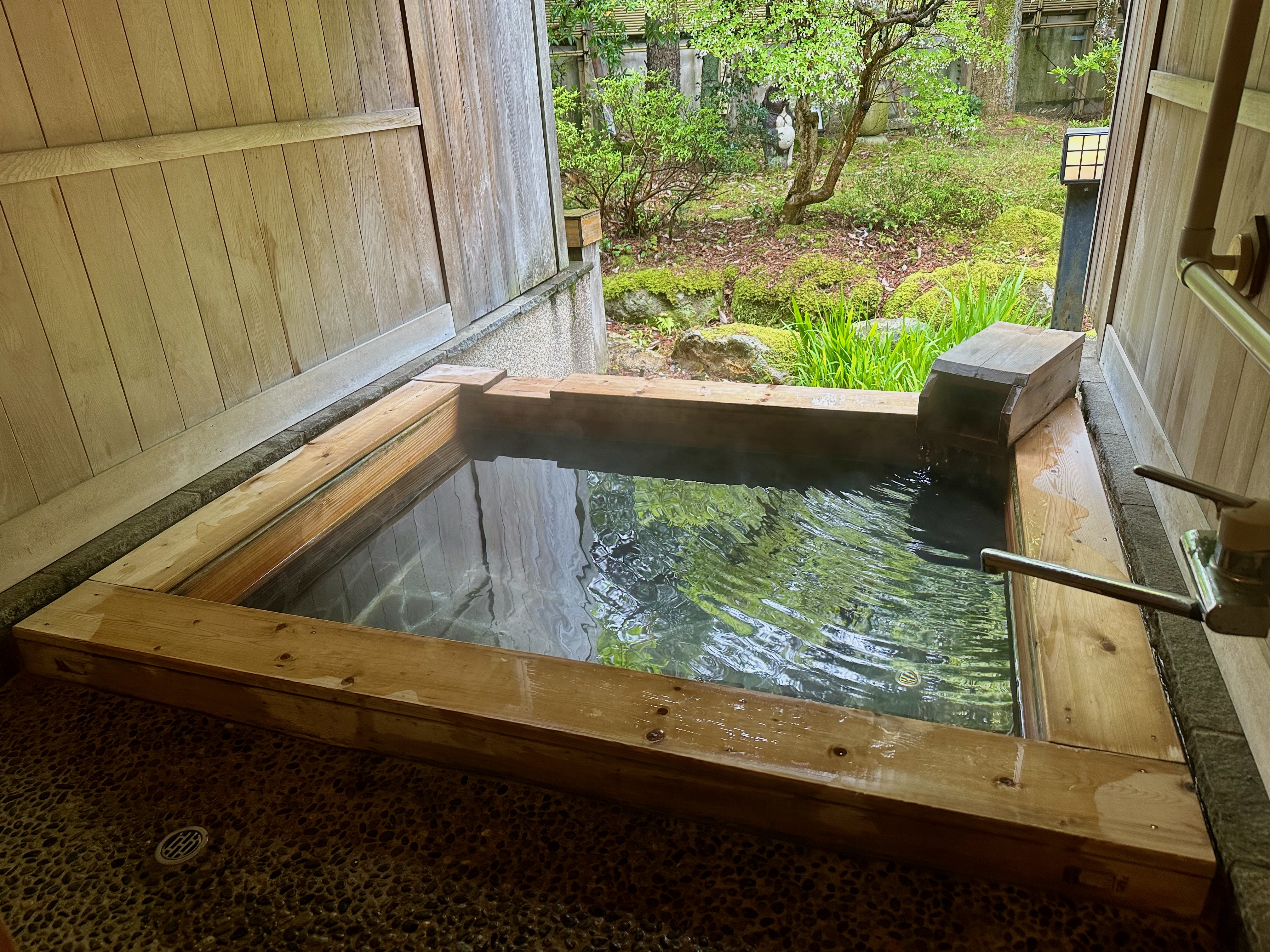
Back at the ryokan, we had a langorous soak in the onsen and another beautiful and delicious kaiseki meal before turning in for the night.
Time to leave the ryokan. In the morning, we checked out at 10:00 and took the shuttle to the train station. In Kanazawa, we bought a pair of tickets for the 新幹線 to 東京 .
We arrived in Tōkyō in about 3.5 hours. Fast trains gonna go fast.
Our train dropped us off at Tōkyō Station, which is quite an introduction to the hustle of Japan’s biggest city. In terms of sheer geographical size and number of people, Tōkyō is on another level from any other city I’ve been in. We wove through the crowds of commuters, found our metro, and ultimately our way to our hotel for the next leg of our trip: the New Otani.
After we got settled, we went for a walk around our new neighborhood. We both needed a little pick-me-up, and we found Hocus Pocus, a small nearby cafe selling donuts and pour over coffee.
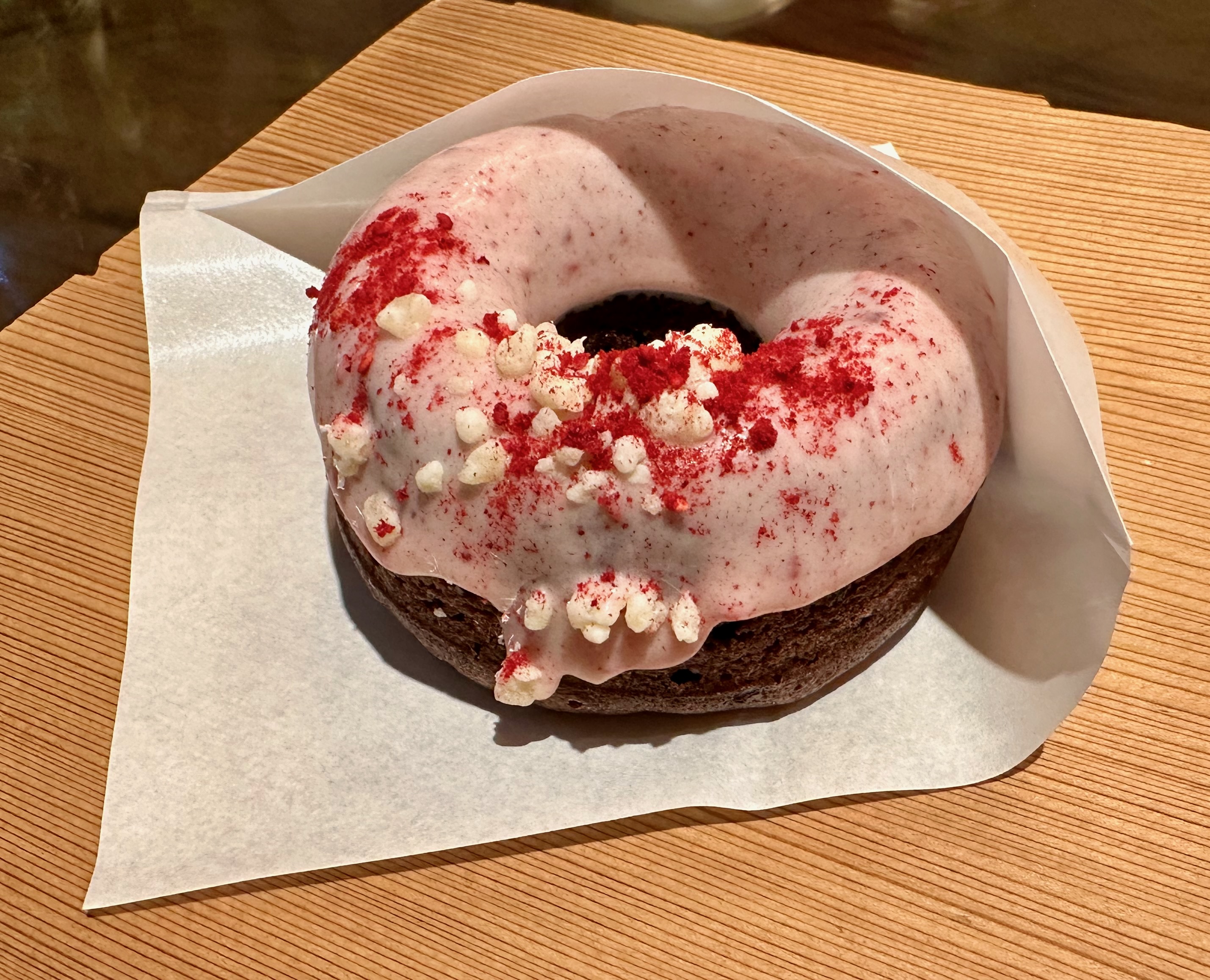
Despite the rain, we still wanted to get out and explore a bit. We took the train over to 新宿 station where I got some good pictures of the bright lights of Shinjuku in the rain. We got soup curry at Dominica, a hard-to-find spot down an alley and a flight of stairs, and one of Tess’ favorite places to eat when she’s in town. It was fantastic. She was also excited to show me some of her favorite spots in Shinjuku 2丁目 , Tōkyō’s gayborhood, so we closed out the night with drinks at Rainbow Burritos.
After more than a week in Japan, this was the first night that I actually slept until a reasonable wake up time: 7 am. Imagine!
We took the train to Shibuya where we found coffee and toast at a small boutique shop called Rec Coffee. This place was great. Tess bought some beans to take home too. ☕️
After coffee, we walked back to Shibuya station to say hello to the goodest good boy that ever was good, Hachiko.
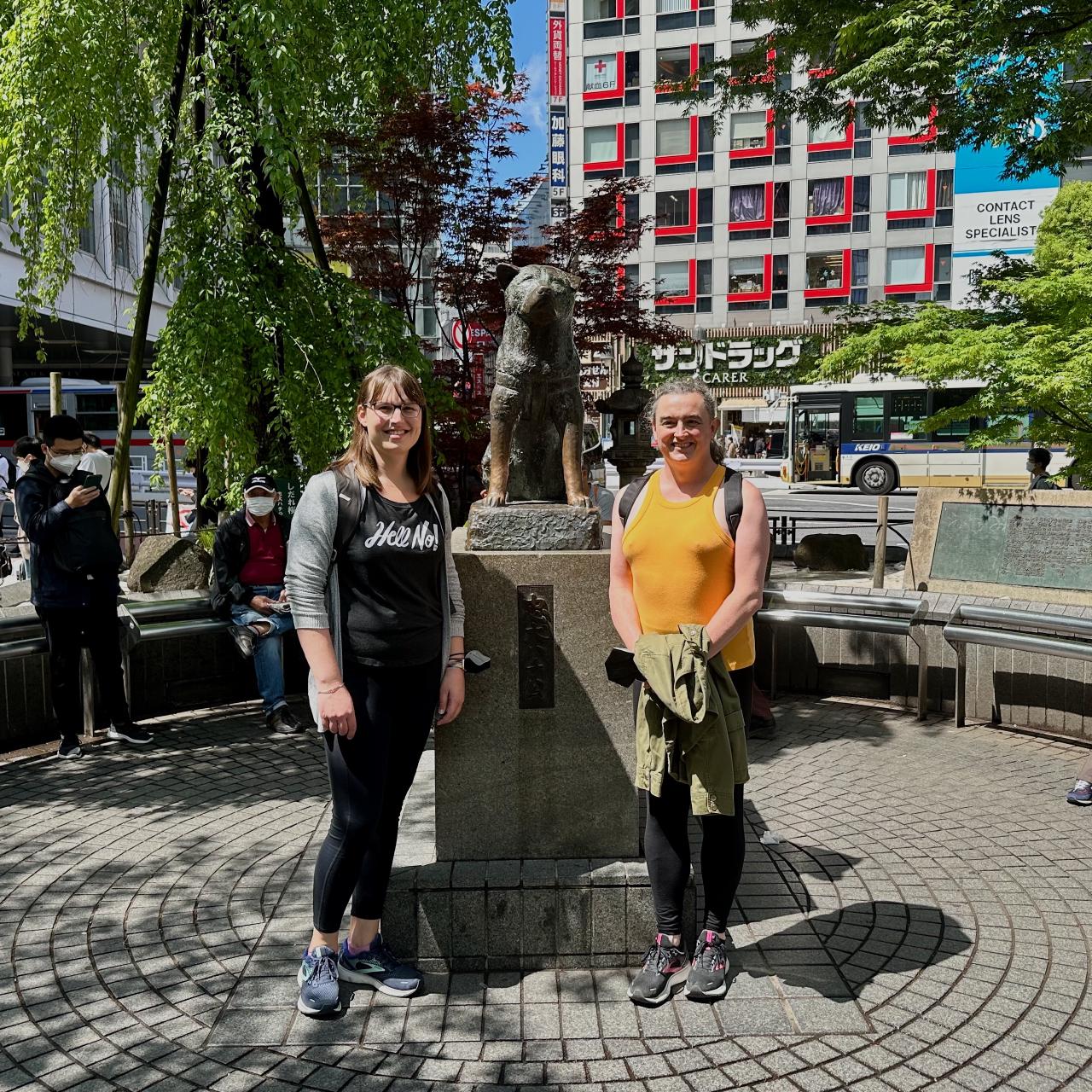
We crossed the Scramble and spent a while perusing the floors of Hands, where we (fortunately; more on that later) bought umbrellas, and then dove into Harajuku.
We got souflée pancakes for lunch at Rainbow Pancake and wandered down Cat Street checking out shops along the way.

Tess’ friend Ray met us at the end of Takeshita-dori as it started to rain. After a surprise, intense rain storm (including some hail and lightning – so glad we happend to buy umbrellas earlier!) we sat and chatted at Blue Bottle, bought some gifts at KIDDY LAND, and I bought a yukata at a vintage clothing store called Chicago.
Ray left us then, and Tess and I continued on. We stopped at Five G, a synth shop full of awesome vintage synthesizers. (More Prophet 5’s and Memorymoog’s than I’ve ever seen in one place before.) We took a quick walk through an adorable watchmaking experience at Seiko Seed. And managed to squeeze in a visit to 明治神宮 just before they closed the gates.
We wrapped up our day with dinner at Sushizanmai and a drink at Goodbeer Faucets.
In the morning, we took the Ginza line to Tawaramachi and stopped at Pelican Café for toast and coffee.
From there we walked up to 雷門 , a famous gate with an enormous red lantern in the middle. On the other side is a street lined with stalls and shops that leads up to 浅草寺 . We got a 苺大福 from one of the vendors and wandered through the throng of tourists up to the temple.
From there, we walked down 合羽橋 , a street lined with shops selling kitchenware. We stopped in a several knife shops, as well as one selling interesting and vintage coffee equipment.
We got soba for lunch near 上野駅 and then took the train a few stops to visit a traditional Japanese garden called 小石川後楽園 near the Tōkyō Dome. Afterward, we stopped into Hop Scotch for beer and some gyoza.
We finished our day at やさいや in 赤坂 .
In the morning, Tess and I got breakfast at Ueshima, a small café in Akasaka. It’s a simple place with decent toast and coffee. It sees a mix of Tōkyō residents stopping in on their way to work and tourists looking for a familiar breakfast. She had a few meetings in the morning, so I was on my own for a while.
I took the train up to 都墨田区 , stopping by the 両国 Sumo Hall on my way up to the Japanese Sword Museum. It’s a small museum situated in the Former Yasuda Garden that highlights the traditional ironworking practice in Japan, especially (though not exclusively) as it pertains to sword-making. They have a number of beautiful finished swords on display as well.
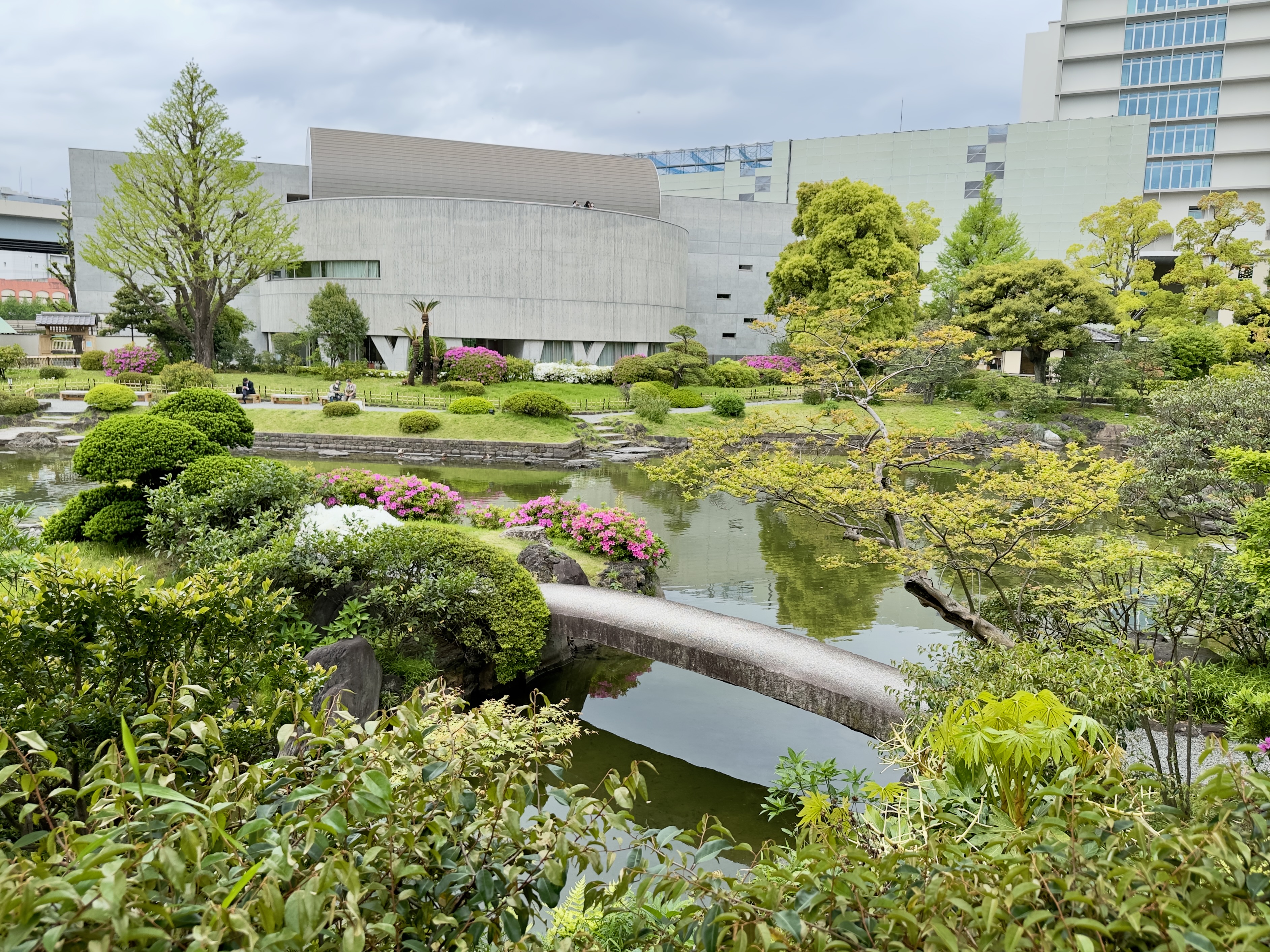
After the museum, I stopped for lunch at a nearby sushi restaurant and walked from Asakusa into Akihabara. I did a quick turn through ヨドバシ to look at cameras, and then hopped on the train to meet Tess.
We met in the middle of Shinjuku-Gyōen and wandered the pathways exploring the gardens and the remants of the cherry blossoms. (We were late for 花見 by just a few weeks, but we’ve been able to see a few late bloomers here and there!)
That evening we met up with our friend Ray for dinner at GANTZ and a quick drink at a tiny but lively lesbian bar called Elle Vie.
Tess and I went back to Ueshima for breakfast. This was her first full day back to work, so she caught the train to Shibuya and I got a train for my day’s exploration: 鎌倉 and 江の島 .
Kamakura is an old town by the ocean with a number of interesting shrines and temples. I stopped at Amanawa Shinmei Jinja, a shrine to Amaterasu Ōmikami built in 710, making it the oldest shrine in the city.
The big draw in Kamakura is 高徳院 , a Buddhist shrine known for it’s Great Buddha statue. It’s rare to see these large statues outside, and to be able to get so close to them. This one even lets you go inside!
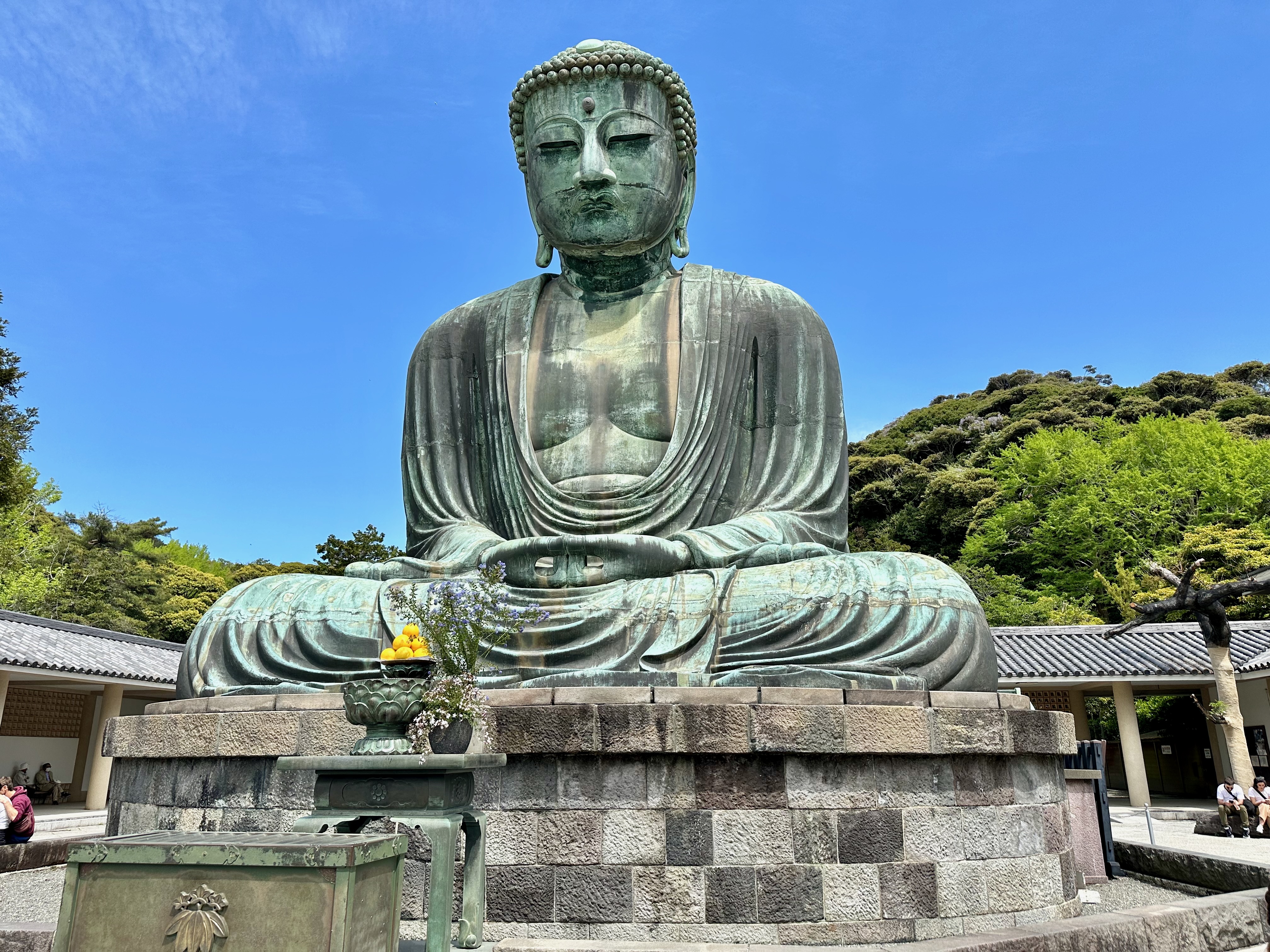
I also visited 長谷寺 temple situated up in the hills overlooking the ocean. This one is also well known for it’s rows and rows of little Buddha statues. I had lunch in a cafe on the temple grounds, and scored a fantastic seat right at the window overlooking the bay.
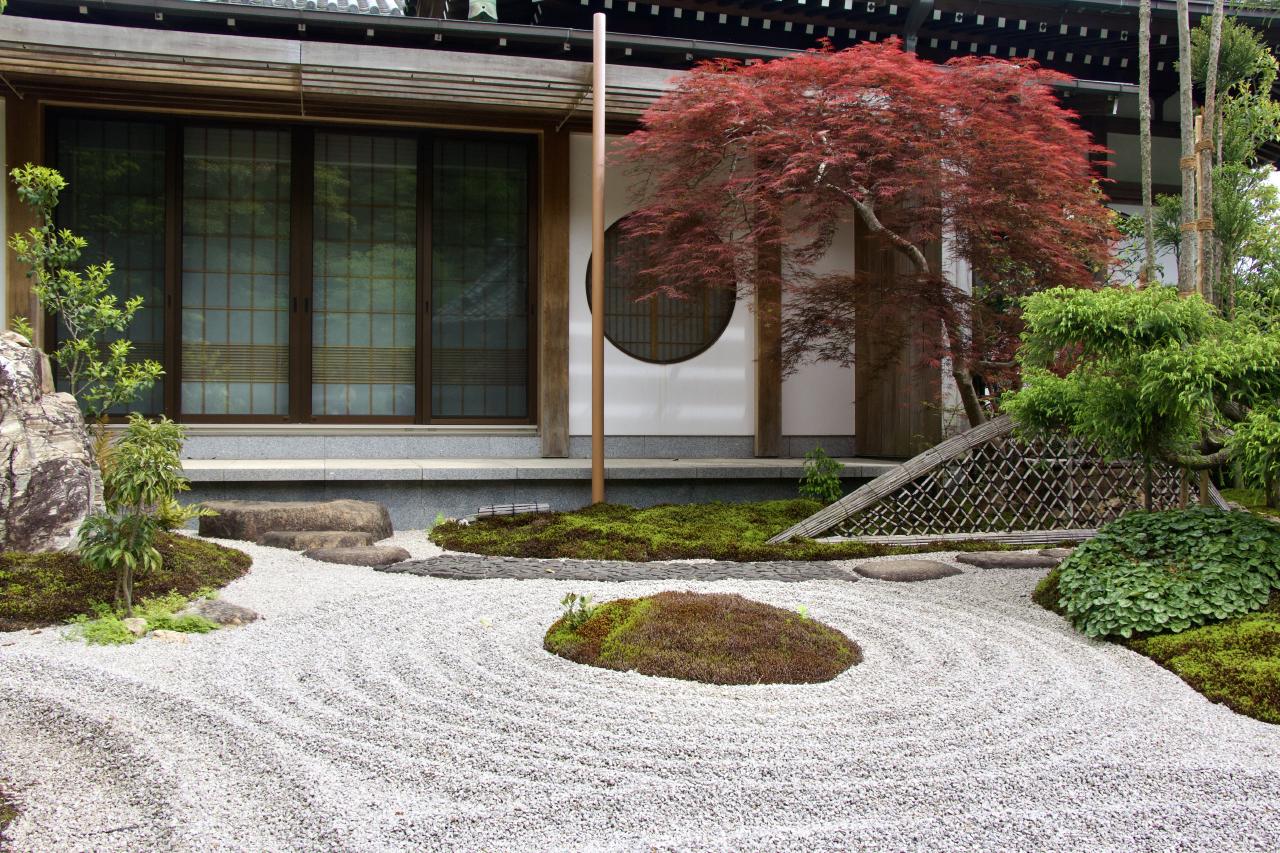
To get to Enoshima, I took the Enoden line along the coast. Enoshima and it’s mainland town remind me of beachtowns back home. There are little shops selling beachy clothing, sandals, and shells, and snack shacks to get a quick bite. The island itself is connected to the mainland by a causeway and is home to a cluster of Shinto shrines. It’s picturesque and apart from the humidity, I enjoyed wandering all over the island. On clear days, Mt. Fuji is a grand presence toward the west. I got a few pictures of it just barely visible through the afternoon haze.

I took the train back from Enoshima station to Shibuya where I met up with Tess and her fellow TAG members for dinner at a yakiniku place in Ebisu.
Tess and I got breakfast at Starbucks under Shibuya Stream. Having gone pretty hard the day before, I decided to take it easy. I stayed at the Starbucks for a few hours and then I took the train out to Shimokitazawa.
I got lunch at Soup Curry Cocoro and wandered the neighborhood, exploring the shops and enjoying the vibe. I stopped in at Jet Set, a cute little record shop hidden on the second floor of a building down the street from my lunch spot, and Tsutaya Bookstore.
Tess insisted I try Bear Pond Espresso, so I got an ice latte (which was fantastic, by the way) and hung out for a little while practicing my Japanese and watching people come and go.
I hopped back on the train to Shibuya to meet the TAG folks for dinner. We had dinner in a place below Shibuya Stream called Na Kameno Teppen, and then headed down the street for drinks at INC, where I had an excellent old fashioned.
We grabbed a quick breakfast at Cafe Veloce in Shibuya in the morning and then Tess went off to work for the day.
I walked from there to a small “coffee bean shop” called KOFFEE MAMEYA in Harajuku. They sell a bunch of different coffees. When I walked in, I was greeted by one of the staff who talked me through a chart showing all their beans, organized by acidity, roast level, and flavor notes. He helped me choose one that met my preferences and then directly me to a counter. Both of the guys I talked to were knowledgeable and made good recommendations based on my flavor preferences. They spoke very good English too! After a tasty cup of cold brew, I walked out with two bags of beans that I’m looking forward to roasting at home.
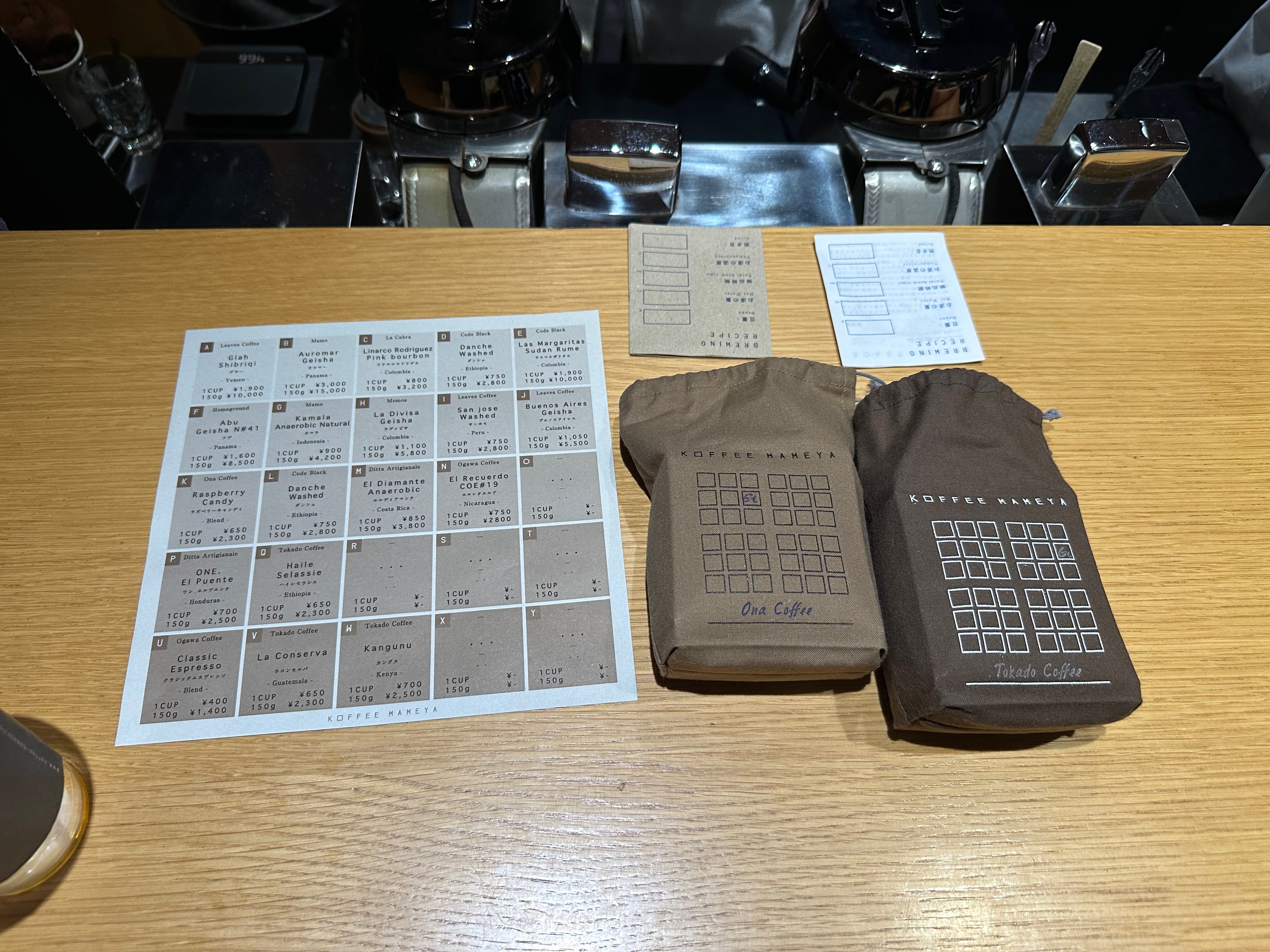
Coffee Part Two accomplished, I took the train up to Ueno Park to the Tōkyō National Museum. They have a really cool collection of swords by famous sword smiths throughout Japan’s history, some great examples of Japanese pottery, and tons of calligraphy and Buddhist religious art. I also appreciated their collection of Ainu and Ryukyu artifacts. They were also running a special exhibit on art from 東福寺 temple in Kyōto, the site where Zen Buddhism entered Japan for the first time.
I met Tess and the TAG folks for dinner that night at Sushizanmai in Shibuya, and a couple drinks (including some tasty mocktails for me!) at Trench. Their main location was full up so they sent us to their Annex on the fifth floor of a building around the block. It was a great space with tasty drinks.
The TAG meeting finished, Tess and I got to spend the day together. We decided to explore Ginza. Tess found bill’s for breakfast, which is a cool spot on an upper floor of a building nestled between the Ginza locations of several high-end fashion brands.
We wandered through Ginza, looking in the windows of all the high-end designer shops. Along the way we stopped into a Bic Camera, where Tess finally found the watch of her dreams: a Grand Seiko SBGM221.
Eventually we came to 東京駅 , an incredible red brick building built during the Meiji Era as part of Japan’s moderization effort at that time.
The Imperial palace grounds were a straight shot vaguely eastward. We took a few photos of the few buildings and bridges we could see, but honestly there isn’t much.
We wandered through Hibiya Park, a nearby Western-style garden, and back into Ginza to visit the Seiko museum. Tess had been wanting to go on this trip. It’s an interesting exhibit of the history of Seiko, a company that has had a huge impact on the modern history of watches and watchmaking. I enjoyed seeing all the different timepieces they’ve made over the more than 120 years since its founding.
We stopped at Centre for a late lunch, and to fulfill another one of my goals for this trip: to have a strawberry and cream sandwich. It’s exactly as amazing as it sounds and exceeded all my expectations. Yummm.

We met Mike and Naoko Smith, and their kids Zen, Mui, and Mila, that evening for some cozy hangout time at their home – Zen and I went a few rounds of Smash Brothers and Mario Kart on their Switch – and dinner at St. Buffalo in Shinjuku.
Our last full day in Japan was a fun one. We finally got back to Rec Coffee for breakfast: yummy coffee and honey butter toast.
From there we walked to Yoyogi Park for Tōkyō Rainbow Pride. Tess’ friend Mamiko and her partner Satoko invited us to march in the parade with their にじいろ家族 contingent. Tess and I both had a great time marching and taking in the celebrations. It’s so so great to see queer people of all kinds in community together, and it feels good to be a part of that. I’m really grateful to Mamiko and Satoko for their invitation.

After the parade, we grabbed a coffee (and a welcome rest for our tired feet) at Beasty. We took a walk through Shinjuku, stopping at a few shops, and taking a moment at 花園神社 to say hello to the local kami and Inari-Ōkami.
We stopped in at どんよく for another little snack and some tea, then wandered down the hall for some drinks and food at どろぶね with Ray.
Feeling a little light on food, we stopped at a コンビニ near our hotel for some katsu sandwiches and ice cream mochi before turning in for the night.
Last day. We were up early to get everything packed up. We grabbed brekkie at Byron Bay Coffee, then took a walk over to Toyokawa Inari Tōkyō Betsuin, a shrine near our hotel dedicated to Inari that combines the Shinto and Buddhist traditions on one site. It was full of shrines to various aspects of Inari, including some Buddhist images.

We got notified that our flight was delayed, so we unexpectedly had a few more hours to spend. We got lunch at a quick, greasy ramen place in Akasaka, paying for our meal at a machine at the door and sitting at the counter with the the other office workers dropping in for a quick lunch.
We were off to the airport not long after that, and eight and a half hours later we landed in SFO.



